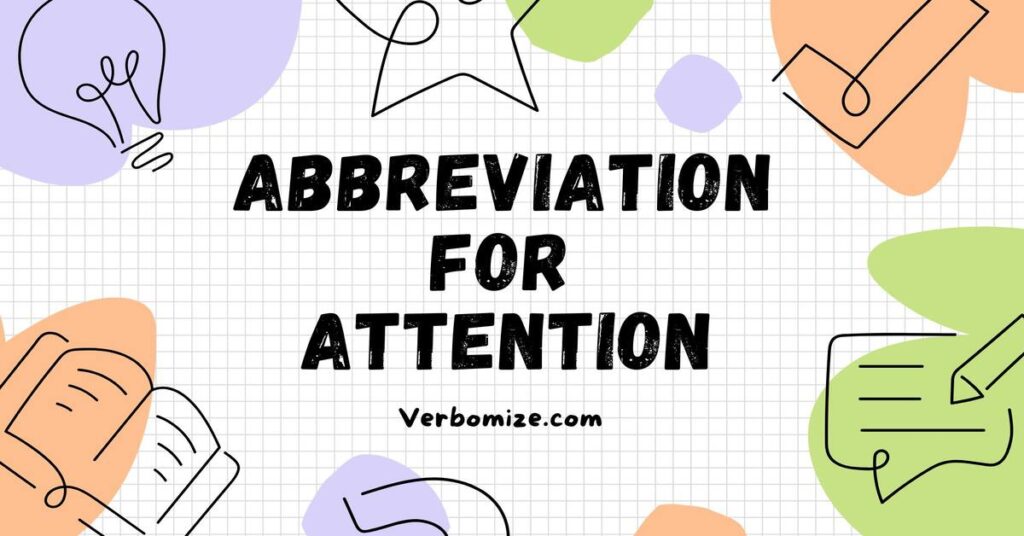Abbreviation for Attention is a small yet powerful tool that you’ve probably encountered in emails, letters, or business correspondence. But do you know exactly what it means and how to use it effectively? Understanding how to use “Attn” can save you time, avoid confusion, and make your professional communication more efficient.
In this article, we’ll dive deep into everything you need to know about this handy abbreviation—its meaning, pronunciation, and best practices. Whether you’re drafting an email or managing business letters, mastering “Attn” will help you get your message across with clarity and precision. Keep reading to learn more!
what’s the abbreviation for attention
The abbreviation “Attn” stands for “Attention”. It is commonly used in both formal and informal communication to direct someone’s focus toward specific information in a letter, email, or other written documents. When you see “Attn”, it typically signals that the content following it is important and requires immediate notice.
In professional settings, the abbreviation is commonly used when addressing correspondence to a specific person, department, or group within an organization. For example, you might see it in business letters, memos, and emails.
Understanding the Meaning of “Attn”
The abbreviation “Attn” is derived from the full word “Attention”. It serves as a shorthand version to indicate that the reader or recipient should pay special attention to the information that follows. This is especially useful in formal writing, where brevity and clarity are essential.
When used, “Attn” directs the reader’s focus to a specific person or department within an organization. For instance, if you’re sending an invoice to a company, you may want to ensure it reaches the accounts department. In this case, you would write:
Attn: Accounts Payable Department.
This usage helps ensure that the letter or document reaches the right person or department quickly and efficiently, without causing confusion.
Why Do We Use the Abbreviation for Attention?
Abbreviating the word “attention” into “Attn” helps save time and space, making written communication more efficient. Here are a few key reasons why it’s widely used:
- Space-saving: In documents where space is limited, such as invoices, memos, and emails, using an abbreviation allows the writer to keep the content concise and to the point.
- Clarity: In formal business communication, using “Attn” clarifies that the message is intended for a particular person or department, minimizing the chance of misdirection.
- Efficiency: In fast-paced environments, like corporate offices or customer service, abbreviations allow messages to be processed quickly and efficiently.
By using “Attn”, the writer ensures that the message doesn’t get lost or overlooked, especially in environments where many people might be involved in handling communications.
Are There Other Abbreviations for Attention?
While “Attn” is the most common abbreviation for attention, there are a few other variations, although they are not as widely used:
- ATN: Sometimes, especially in more informal contexts, the abbreviation ATN might be used instead of “Attn.” This variation, however, is much less common and is often seen in specific industries or regions.
- “Re:”: This is another common abbreviation in business communication, particularly in emails. While not a direct synonym for “Attn”, it directs attention to the subject of the message. For example, “Re: Invoice #12345”.
- “FYI”: This stands for “For Your Information” and serves a similar purpose by highlighting important content or directing someone’s attention to specific information.
Even though ATN is less common than Attn, it’s still useful to know the other variations to ensure you understand their context in communication.
Pronunciation of “Attn”
The pronunciation of the abbreviation “Attn” can be a bit confusing for those unfamiliar with it. It is often pronounced as:
- “A-T-T-N” (pronounced by saying each letter individually: “A,” “T,” “T,” “N”). This is the most common pronunciation, especially in formal or professional contexts.
However, in casual speech, it is occasionally pronounced as “Attention”, particularly when someone reads out a document aloud. But for efficiency in quick communication, spelling out the letters is preferred.
Best Practices for Using the Abbreviation “Attn”
Using “Attn” correctly is key to effective communication. Here are a few best practices to consider:
- Place it at the beginning: In professional correspondence, such as letters or emails, “Attn” should appear at the top of the document, often followed by the recipient’s name or department.
Example: Attn: Jane Doe, HR Department. - Use in formal and business communication: “Attn” is primarily used in business emails, memos, invoices, and formal letters. Avoid using it in informal texts or social media posts, where a more conversational tone is expected.
- Don’t overuse it: While “Attn” is useful, overusing it in a single document can make the content look cluttered. Use it only when necessary to highlight important recipients.
Remember, the purpose of “Attn” is to direct attention, so it should be used strategically in documents that require specific focus.
Acronyms vs. Abbreviations: The Case of Attention
It’s essential to distinguish between an abbreviation and an acronym. While both involve shortening words, there are key differences:
- Abbreviation: A shortened form of a word, often consisting of the first few letters or parts of the word. “Attn” is an abbreviation because it’s a shortened version of “attention.”
- Acronym: A word formed from the initial letters of a phrase or name, like “NASA” (National Aeronautics and Space Administration).
Attn is not an acronym because it’s not derived from the first letters of a phrase but from a single word. In contrast, “ASAP” (as soon as possible) is an acronym.
Common Mistakes to Avoid When Using “Attn”
When using the abbreviation “Attn”, there are a few common mistakes to avoid to ensure your communication is professional and clear:
- Incorrect punctuation: Always use a colon after “Attn” to separate it from the name or department that follows.
Correct: Attn: Marketing Department
Incorrect: Attn Marketing Department - Misplacement: The abbreviation should be placed at the top of the document or in the subject line of an email. Don’t bury it in the body of the content.
- Overuse: Don’t clutter your documents with unnecessary abbreviations. Use “Attn” when it’s crucial to direct focus, not just for every recipient.
- Lack of context: Simply writing “Attn” without additional context can confuse readers. Make sure the document is clear and the recipient’s role or department is identified.
Synonyms and Antonyms of “Attention”
Grasping the synonyms and antonyms of “attention” can enhance your vocabulary and allow you to use words more effectively in various contexts.
Synonyms for Attention:
- Focus
- Notice
- Awareness
- Concentration
- Regard
Antonyms for Attention:
- Neglect
- Disregard
- Indifference
- Unawareness
- Inattention
These synonyms and antonyms allow you to choose the most appropriate term depending on the context of your communication.
The History Behind the Abbreviation “Attn”
The word “attention” comes from the Latin “attendere,” meaning “to stretch toward” or “to pay heed.” Over time, the word evolved through Middle French into English. The abbreviation “Attn” became common as written communication began to prioritize brevity and clarity.
Historically, abbreviations like “Attn” helped streamline documents, especially when handling large volumes of correspondence. Its use in business communication became more prevalent as organizations began formalizing their internal and external communication methods.
Other Examples of Abbreviations for Common Words
In business writing and other professional settings, abbreviations are not limited to “Attn”. Here are a few other common abbreviations that serve similar purposes:
| Abbreviation | Full Form | Common Use |
|---|---|---|
| FYI | For Your Information | Used to share information without requiring action |
| RE | Regarding | Used in emails and letters to refer to a topic or subject |
| FWD | Forward | Used to indicate a message is being forwarded |
These abbreviations help streamline communication and focus attention on the most important aspects of the message.
Real-World Examples of “Attn” in Action
Here are some real-world examples of “Attn” used in professional correspondence:
- Example 1:
Subject: Invoice for Services – Attn: Accounts Payable
“Dear Sir/Madam,
Attn: Accounts Payable Department,
Attached is Invoice #12345 for services rendered. Kindly process the payment at your earliest convenience.” - Example 2:
Subject: Special Notice – Urgent Action Required
“Attn: Customer Relations Team,
We have received a complaint regarding your recent product shipment. Immediate action is required to resolve this issue.”
In both examples, “Attn” helps direct the recipient’s focus toward a specific department or action.
Final Thoughts on Using the Abbreviation for Attention
The abbreviation “Attn” is a small but powerful tool in business communication. It helps direct focus and ensures that the right person or department handles a message promptly. By using it correctly, you can improve the efficiency of your written communication, saving time and avoiding confusion. Always be mindful of its placement, pronunciation, and appropriate usage to maintain professionalism in your communication.
By understanding the meaning, pronunciation, and context of “Attn”, you’ll be better equipped to use it effectively in both formal and informal settings.

Jone Smith is an experienced blogger and content creator behind Verbo Mize. With a passion for storytelling and insightful commentary, Jone brings a wealth of knowledge on diverse topics. His expertise in blogging, combined with a keen eye for detail, makes his work both informative and engaging, offering readers valuable perspectives on a wide range of subjects.







